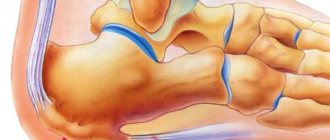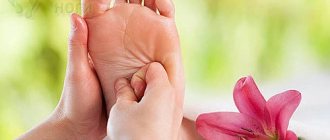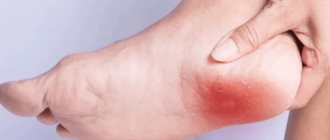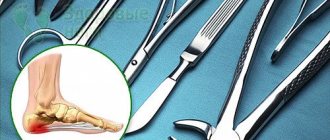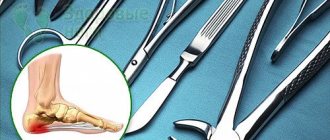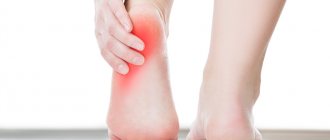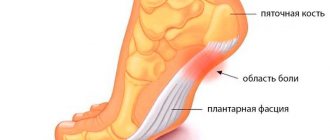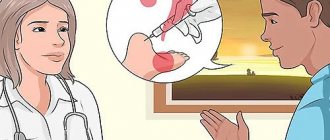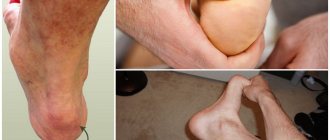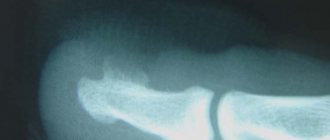Heels: Pixabay Treatment for heel spurs is very varied and includes a wide range of methods - from physical therapy and folk remedies to medications and surgery. The list of causes that provoke the disease is also not small. Considering the prevalence of this pathology in people over 40 years of age, it is better to find out in advance what a heel spur is and prevent its development.
Symptoms of heel spurs, treatment methods
A heel spur is the formation of a bone growth on the tubercle of the heel bone, which causes a person to experience discomfort when walking.
The disease most often occurs in women under 45 years of age. The causes of heel spurs and contributing factors are as follows:
- flat feet and calcaneal injuries;
- pregnancy;
- age-related changes;
- overload of the feet (playing sports, wearing high-heeled shoes, standing work);
- overweight;
- diseases accompanied by circulatory disorders (diabetic angiopathy);
- metabolic disorders;
These factors lead to microtears of soft tissues, which result in aseptic inflammation of the muscles and mucous bursa located under the heel bone. The next stage is the sweating of fluid into the tissue, which impairs blood microcirculation, and the deposition of calcium salts with the formation of an osteophyte (bone growth). The main symptom of a heel spur is a sharp pain with maximum intensity in the morning.
Causes
The causes of heel spurs include the following:
- Injuries. Basically, such growths begin to form after jumping from a great height, when upon landing the heel and surrounding tissues are damaged, and therefore inflammation begins.
- Flat feet. This reason is due to the fact that the load on the foot is distributed incorrectly. As a result, the heel experiences more stress than in the correct position.
- Various joint diseases (for example, rheumatoid arthritis), as well as sprains.
- Overload of the foot area associated with external influences. A very common situation is the wrong choice of shoes. Moreover, the problem is not only in heels - for example, narrow ballet flats and shoes with very thin soles are also undesirable for the heel. Overload of the feet is often associated with work, if a person stands or walks all day.
- Gout. With this disease, excessive salt deposition occurs, which affects all joints and bones.
- Diseases associated with poor circulation, such as diabetes.
- STI. Chlamydia, gonorrhea and other infections affect the condition of the joints, and therefore, over time, a heel spur may develop.
- Natural changes in the body that are associated with age. Again, as the body ages, tissues become less healthy and perform their natural tasks less well, so the appearance of bone growths is quite common.
The causes of the problem cannot always be determined accurately - they are often identified during other examinations or are not relevant right now for the treatment of the disease.
Diseases that contribute to the development of heel spurs
First of all this:
- vascular pathology – diabetic angiopathy, atherosclerosis. Due to impaired blood supply, the elasticity of the fascia deteriorates, which leads to their ruptures;
- diseases of the musculoskeletal system - arthritis, ankylosing spondylitis, polyarthritis. Inflammation of the joints is accompanied by pain, and this leads to a change in gait and improper distribution of the load on the feet;
- autoimmune diseases – lupus erythematosus, rheumatism;
- infectious diseases of the genital area - gonorrhea, mycoplasmosis, syphilis.
Traditional methods of treatment.
Sand, salt, lavender oil, anti-inflammatory foods, baking soda
The sand is heated in the oven and the foot is immersed in it until the sand cools down.
You can use half a pack of salt instead of sand. It is better to do these warm-ups before bed. Apply lavender essential oil.
According to a 2015 study, lavender essential oil has anti-inflammatory properties. Try dissolving one or two drops in olive or coconut oil and massage your feet with it. You can also try adding a few drops to a warm foot bath.
Compresses are also made with salt (ten milliliters of iodine tincture and a tablespoon of honey are added to a tablespoon of salt), which are applied at night a couple of times a week (in the morning it is advisable to walk around with the compress for about 15 minutes). Foot baths are also good at soothing pain: boil a salt solution (a kilogram of salt per five liters of water) and, after cooling it down so that the foot can tolerate it, keep it in this solution until it cools down. The procedure is repeated daily for 10 days.
Eat anti-inflammatory foods. The following foods: turmeric, ginger, cayenne pepper and cumin seeds are known for their strong anti-inflammatory properties. These products contain natural antioxidants and polyphenol. And they act as protective compounds and help reduce inflammation. You can prepare a decoction of 1 teaspoon of ginger, turmeric or pepper powder and warm water. Drink this whenever pain occurs. With cumin seeds, you can boil them in water, strain and drink them to relieve pain.
Baking soda. You'll be surprised at the many things this humble kitchen ingredient can be used for. Baking soda has many benefits, from beautiful skin to teeth whitening. It acts directly on the calcium crystals deposited in the heel. Make a paste by mixing half a teaspoon of baking soda with water and apply it to your heel. Baking soda also helps balance pH levels.
Cabbage, vinegar, aloe vera
Cabbage leaf compress. It's no joke - some people recommend using cabbage to relieve heel pain. Soften some cabbage leaves. Secure the leaves with gauze or a bandage and leave overnight. Some people recommend pouring honey over the cabbage leaves before setting them. Cabbage contains a pigment called anthocyanin, which relieves replenishment.
Apple cider vinegar is a common home remedy for a wide variety of ailments. Mix one cup of apple cider vinegar and 6 cups of warm water in a bathtub or container. Soak your sore feet in water for 30 minutes. Apple cider vinegar is rich in nutrients and minerals, including magnesium, which can be absorbed through the skin.
Aloe vera seems to be growing in popularity as a panacea and superfood (or in some cases, superdrink). This plant is rich in antioxidants and antibacterial properties and is also very beneficial for the skin. Aloe vera can be rubbed into the skin topically. Aloe vera contains mucopolysaccharides, which have anti-inflammatory properties.
Massotherapy
Ball massage . This massage is useful for relieving pain. To relieve the pain associated with a heel bone spur, it is necessary to massage the calf muscles. This stimulates blood circulation, which leads to relaxation of the calf muscles, reducing stress on the foot.
For a massage you can do yourself, use a small ball and roll it along the bottom of your foot. You can also use a simple massage roller. This can be done while you are sitting at your desk or on the couch in front of the TV. Many people follow this method to bring immediate and long-lasting relief.
Bottle massage. Sit on a chair with both feet on the floor. Raise one leg and place a water bottle under the middle of your foot. Slowly roll the water bottle from the ball of your foot to your heel, leaning forward to apply more pressure as you massage. Continue rolling the water bottle back and forth from your heel to the ball of your foot about 10 times and repeat with the other leg.
Iodine
You need to crush an analgin tablet, add a little iodine to the powder and mix, apply the resulting mixture to the heel. You can make baths: add a tablespoon of soda and 15 drops of iodine to three liters of water.
Magnesium
Magnesium is an essential mineral for bone formation and calcium utilization. More than half of the magnesium in the human body is stored in the bones, and the body requires it for protein synthesis.
One way to treat heel spur symptoms is to take a warm bath with Epsom salts. Epsom salt is magnesium sulfate. Which has many beneficial properties when it comes to relieving pain and inflammation. Add a cup of Epsom salts and gently massage your heels to relieve pressure.
There are also many great magnesium-rich foods that supply you with magnesium. For example, avocados contain high amounts of magnesium. Pay attention to spinach and bananas, they are also excellent sources of magnesium. Finally, pumpkin seeds, lentils, white beans, brown rice, millet and dried figs also contain magnesium.
Compress made of honey and dough, curd dressings
Heel spurs are treated with folk remedies by smearing the heel with honey, putting some dough on it, putting on a plastic bag and a warm sock.
Three tablespoons of fresh cottage cheese are placed on a bandage folded in several layers and tied to the heel. The procedure is carried out three nights in a row.
Diagnostics
A specialist of any profile will tell you which doctor to contact if you have symptoms of a heel spur. The orthopedist will make an accurate diagnosis based on a history and examination of the patient. The results of an X-ray examination of the foot are of great importance. On an x-ray, as a rule, a spike on the heel tubercle is clearly visible. Among the auxiliary research methods, a general blood test and MRI of the foot can be prescribed.
Differential diagnosis should be carried out for diseases such as:
- bone tuberculosis;
- rheumatoid arthritis;
- gout;
- osteomyelitis.
Ointments
Iodine ointment
This ointment effectively relieves inflammation and eliminates pain: crush anti-inflammatory tablets (analgin or indomethacin) and mix them with an iodine solution. When the tablets are completely dissolved, apply the ointment to the heels.
Two procedures are enough, with a week break between them.
Egg-vinegar ointment
Combine egg, vinegar (100 milliliters) and rendered lard (100 grams). Leave to infuse for 3 weeks, stirring daily. The finished ointment is applied to the previously steamed heel and sealed with an adhesive plaster. If a strong burning sensation occurs, the bandage is removed.
Warming up
Coarse salt is heated well and poured onto the floor. They walk barefoot on the salt for a quarter of an hour. Two procedures are enough to get rid of pain.
Boil small potatoes “in their jackets”, salt them well. Pour it into a bowl and stir with your feet until it cools. After the procedure, an iodine mesh is drawn on the heel and socks are put on. Duration of therapy is a week.
When the legs are heated, the blood vessels dilate, resulting in improved blood circulation, elimination of muscle spasms, and lengthening of tendons and ligaments.
Effective treatments for heel spurs
Drug treatment of heel spurs is preceded by identifying the cause that led to the formation of the osteophyte.
The doctor selects the treatment method individually, taking into account the patient’s condition and the location of the thorn. Self-medication in this case is unacceptable.
Effective treatments for heel spurs:
- local drug therapy (gels, ointments);
- shock wave therapy
- impact on bone growth with ultrasound and laser;
- magnetic resonance therapy;
- X-ray therapy;
- surgical treatment.
The laser treatment method for heel spurs is effective at any stage of the disease. The laser has an analgesic, anti-inflammatory and decongestant effect.
Shock wave therapy helps strengthen ligaments, relieve pain, relieve inflammation and resolve bone growths. The effectiveness of the method is comparable to surgery.
Surgical removal of a heel spur is usually prescribed if there is no positive result after conservative treatment.
Magnetic resonance therapy has an anti-inflammatory and anti-edematous effect, and also improves the functional abilities of blood vessels.
X-ray therapy of heel spurs is used for intense pain. The X-ray beam blocks pain impulses, relieving pain.
In case of intense pain, the doctor may prescribe heel spur blockade with corticosteroid drugs (Kenalog, hydrocortisone). The blockade is carried out strictly according to medical indications.
Competencies
$APPLICATION->
Heel spur - causes, prevention and treatment methods
- Mechanism of disease development
- Causes of heel spurs
- Symptoms of heel spurs
- Diagnosis of heel spurs
- Prevention and treatment of heel spurs
A heel spur is a pathology that affects many people. The appearance of a small protrusion on the surface of the bone does not cause discomfort at first, but over time it leads to the development of pathology with burning pain. The disease rarely occurs on its own and is usually a consequence of concomitant problems with the musculoskeletal system and the body as a whole.
Mechanism of disease development
A heel spur is a small bony growth on the surface of the heel bone. The occurrence of symptoms of pathology is directly related to plantar fasciitis, an inflammation that affects the tissues of the foot. The pathological process extends to the plantar fascia - a connective tissue plate that runs from the phalanges of the toes to the heel bone. Fascia is a very important formation of the foot; it participates in the formation of its longitudinal arch.
As the inflammatory process progresses, microcracks and small injuries form on the surface of the fascial sheath. During sleep, the tears heal and grow together, but as soon as the patient begins to move, they appear again.
Unlike ordinary inflammations, in this case the appearance of a pathological focus is not associated with infection. In response to inflammation, the fascial tissue adjacent to the heel bone begins to actively react. Growths appear on its surface, which over time increase in size and turn into a heel spur. The pain that accompanies the process is a consequence of trauma to the fascia. It usually intensifies when walking, sudden movements, or heavy loads on the heel area.
Causes of heel spurs
A defect on the surface of the heel bone can be caused by a number of serious disorders that affect the normal weight distribution of the foot.
Main reasons:
- Obesity.
Excess weight creates additional stress on the foot, which provokes the appearance of a pathological process. - Flat feet.
Flattening the arch of the foot causes the plantar fascia to become overstretched. This creates conditions for its injury and the appearance of an inflammatory process. - Connective tissue pathologies.
These diseases affect the fascia itself, disrupting its normal structure. - Disappearance of the fat pad of the heel.
The back surface of a normal foot has loose tissue that provides shock absorption when walking. With age, it becomes thinner, and the load on the heel area increases significantly.
In more rare cases, the development of the disease is provoked by the following factors:
- Spinal diseases (for example, osteochondrosis);
- Dislocations, fractures, damage to foot ligaments;
- Gout;
- Disturbances in the metabolism of calcium and other minerals in the body;
- Joint diseases.
The occurrence of pathology may also be associated with an incorrect lifestyle. For example, the structure of the foot is disrupted when constantly working while standing. The shoes that the patient wears also play an important role in the development of the disease. If its sole is dense and thin, the insole does not spring back when walking and injures the fascia.
Symptoms of spurs on the heel
Symptoms of the disease usually appear clearly. It is usually quite difficult to confuse a disease with any other.
The pathology is characterized by the following symptoms:
- Pain in the heel area.
Unpleasant sensations arise suddenly, the pain is very strong. Pain syndrome is especially characteristic for patients with high body weight. Discomfort increases with palpation (feeling) of the affected area. - Skin change.
In the area of the heel spur, deformed bones constantly put pressure on the overlying soft tissue, causing the surface skin to become rough and red. A large callus forms at the site of the skin lesion. - Gait disturbance.
The patient cannot step on the heel and tries to protect it from stress. Because of this, he begins to limp, and his gait takes on a specific character. In severe cases of the disease, the patient uses a cane or crutches. - Muscle tension.
The muscle formations in the foot are constantly under tension. This is noticeable upon palpation.
The clinical picture of a heel spur is quite specific - the pathology is easy to distinguish from others. When the first symptoms of the disease appear, consult a doctor - this way you are guaranteed to avoid its progression.
Diagnosis of heel spurs
When contacting a doctor, you need to tell him in detail about the symptoms of the disease: when they appeared, whether the pain has progressed. It is important to describe in detail the nature of the pain and tell under what circumstances it intensifies (for example, long walking or heavy loads on the foot). A detailed description of the clinical picture of the disease will help the doctor make the correct diagnosis.
When examining the foot, the doctor notes the presence of a large callus on the heel, which is visible to the naked eye. When palpated, you can detect the presence of bone protrusions-osteophytes on the surface of the heel bone.
To accurately determine the disease, the doctor must prescribe a series of instrumental examinations. The simplest of them is radiography of the affected area in several projections. The image will clearly show the position of the bones of the foot, and also notice the bony protrusion that forms the heel spur. The condition of nearby soft tissues can be assessed using ultrasound. It can be used to determine the size of the focus of inflammation surrounding the growth. Based on the data obtained, the doctor makes a diagnosis and prescribes appropriate treatment for the patient.
Treatment of heel spurs in Moscow
First of all, you cannot self-medicate, otherwise the disease will progress and eventually cause serious complications. Only a doctor can choose the right treatment - tactics are individual for each patient.
Changing the patient's lifestyle is of great importance in the treatment of heel spurs.
To do this, he must follow 4 rules:
- Maintain strict bed rest.
- Reduce the load on your leg to a minimum.
- Wear comfortable shoes with thick, springy soles.
- If necessary, move around with the help of crutches and a cane.
Medications
To relieve the symptoms accompanying the appearance of heel spurs, several groups of heel spur treatments are used:
- Anti-inflammatory drugs (Piroxicam, Voltaren, Diclofenac, Ketorol). These products effectively relieve pain and swelling in the heel area. They usually come in the form of ointments and gels.
- Local irritating substances (medicinal bile, Dimexide). These medications stimulate metabolism in tissues, thereby accelerating regeneration processes. They should be used in the form of compresses.
- Additional products (anti-inflammatory patches, creams with natural products and other medications).
The use of drug therapy only helps the patient to relieve symptoms, but does not eliminate the disease. If you self-medicate and do not consult a doctor, the pathology will continue to progress. Conservative therapy should not be the only part of the treatment complex; it should also include procedures that affect the root cause of the disease.
Injection treatment and physiotherapy
Injection treatment is widely used to relieve discomfort due to severe pain. For example, the patient will feel much better if novocaine is injected into his heel - so-called novocaine blockades. To do this, a 0.25–0.5% solution of the drug is taken and injected into the tissues surrounding the pathological focus. The procedure is carried out 2 times daily until the pain disappears.
Another means of injection therapy are derivatives of natural hormones - glucocorticosteroids (Flosteron, Diprospan, Kenalog). They are injected into the point of the heel where pain is felt most strongly. This procedure cannot be carried out constantly - steroid drugs have quite strong side effects. The course of treatment ranges from 1 to 3 injections.
Physiotherapeutic methods for treating heel spurs will also help relieve pain. They are prescribed after the end of the acute period of the disease.
These include:
- Various baths (mineral, paraffin, mud);
- Phonation;
- Magnetotherapy;
- Laser exposure;
- Shock wave treatment.
Massage is also widely used. The most effective treatment for heel spurs is shock wave therapy.
Physical therapy for heel spurs
It is of great importance to perform physical exercises from the complex of therapeutic gymnastics for heel spurs. Exercises are especially useful during the recovery period, when the acute disease process has already been cured. Therapeutic gymnastics is aimed at stretching the plantar fascia. If you do it constantly, the connective tissue plate of the foot will stretch, strengthen and become more elastic. For heel spurs, treatment with exercises gives very good results.
Taping
One of the widely used methods of treating heel spurs is taping. It involves restricting the mobility of the muscles and ligaments of the foot by wrapping them with adhesive tape. The leg is fixed in an extended position - the load on the fascia is reduced.
For the procedure, a specialized tape is used - tape. If it is not possible to purchase it, a wide adhesive plaster, which is sold at any pharmacy, will do. You will also need ether to lubricate the skin and bandage. A line of tape is applied over the entire foot, with the main load placed on the area located in front of the heel.
Orthoses
At night, the patient is recommended to use special devices - night orthoses, which are attached to the leg and clearly fix it in one position. As mentioned earlier, micro-tears in the fascia usually heal overnight, so securing the foot in this position speeds up the regeneration of foot tissue.
Surgery
Surgery is resorted to only in the most advanced cases, when the disease is not amenable to conservative treatment. Heel spur removal surgery is aimed at eliminating the bone growth. It is excised, the fascia above it is shortened, and the nerve fibers compressed by it are released. The patient can move normally, the constant pain goes away.
Recently, laser removal of heel spurs has been actively practiced. This method is less traumatic than classic surgery. Treatment of heel spurs with laser is still widespread mainly only in Moscow, but the method is slowly beginning to be used in the regions.
For heel spurs, the patient is often recommended treatment with folk remedies, which can also be done at home. It is important to note that it is ineffective for this disease. Simply relieving symptoms does not mean solving the problem. Only a doctor can deal with it.
Prevention
Heel spur is a disease that can be avoided if you follow simple recommendations:
- Control your weight;
- Wear comfortable shoes;
- Avoid overloading the foot;
- Exercise;
- Train the foot muscles;
- Treat joint and spine pathologies in a timely manner;
- Eat properly .
Following these simple rules will help you enjoy an easy walk for many years! Listen to your body, pay attention to symptoms in time and do not neglect visiting a doctor.
Insoles and heel pads in the treatment of heel spurs: how to choose
Special insoles and heel pads are a mandatory element in the treatment of heel spurs. They help reduce the load on the heel and improve blood circulation in this area, fix the ligaments in the desired position and reduce the load on the knee and hip joints. You can find out the price of orthopedic insoles used for heel spurs in specialized stores, where a consultant will help you choose the size of the insole and quality material. However, the best option would be to consult an orthopedist. The doctor will examine the characteristics of the foot and select the necessary insole model. It is important to take into account the patient’s weight and the degree of development of the disease.
On our website you can make an appointment with a doctor at a time convenient for you. During your consultation, you will learn how to quickly get rid of heel spurs and which treatment methods will be most effective in your case.
Prevention
Preventive measures in this case include the following:
- Timely treatment of all orthopedic diseases: diseases of the spinal column, flat feet, etc.
- Increased attention to the condition of the joints, preventing their diseases.
- Choosing the right shoes - without high heels, with a stable last, but not too flat.
- Supplementing shoes with special insoles, which are selected with the participation of an orthopedist.
- Moderate physical activity for the harmonious development of muscles, ligaments and joints.
- Elimination of foot overloads and injuries of various types (avoidance of dangerous situations).
- Regular foot exercises.
- Weight control. Excess weight puts significant stress on the heel area, which can contribute to the development of spurs.
- Proper nutrition with enough nutrients.
It is worth adhering to these recommendations at a young age in order to eliminate the risks of developing the disease in the future or to delay the first signs of a heel spur much further in time.
